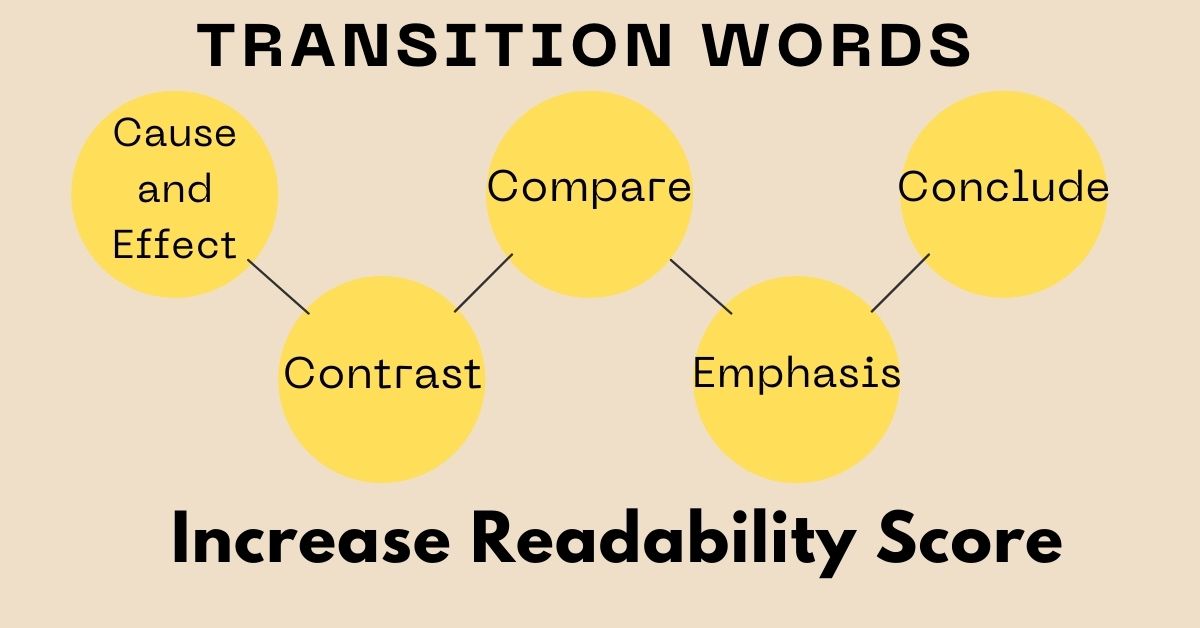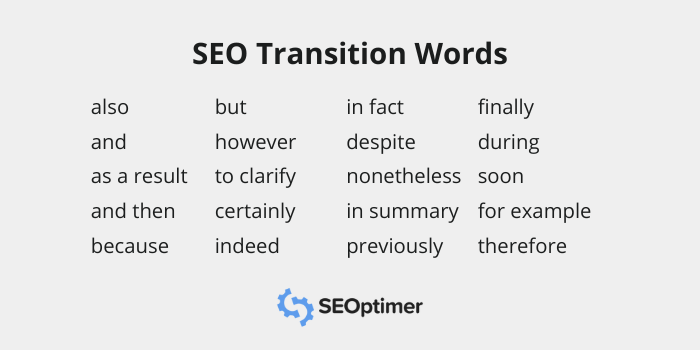Discover how using transition words not only enhances readability, but also boosts your SEO ranking and captivates your audience.

Image courtesy of via DALL-E 3
Table of Contents
Welcome to our exploration of transition words! Transition words are like magical bridges in writing that connect one idea to another, making your sentences flow smoothly. Not only do they help your writing become easier to understand, but they also play a crucial role in SEO (Search Engine Optimization), helping your content rank higher on search engine result pages. Let’s delve into the world of transition words and uncover why they are essential for both readers and search engines.
What Are Transition Words?
Transition words are special words that act as signposts in your writing, guiding readers from one idea to the next. They show the logical relationships between different parts of a sentence or paragraph, making it easier for readers to follow along. Think of transition words as the glue that holds your sentences together, allowing your ideas to flow seamlessly.
Why Should You Care?
Using transition words not only benefits your readers by making your writing clear and organized, but it also helps search engines understand the structure of your content. When search engines can easily navigate through your text, they are more likely to rank your content higher in search results, driving more traffic to your website. So, by mastering the art of using transition words, you can enhance both the readability of your writing and its visibility online.
Types of Transition Words
Addition Words
When you want to add more information to what you are saying, you can use addition words like ‘and’, ‘also’, and ‘furthermore’. These words help to make your writing more detailed and interesting.
Contrast Words
Contrast words are used to show differences between different ideas or situations. Words like ‘but’, ‘however’, and ‘on the other hand’ help to highlight these distinctions in your writing.
Sequence Words
Sequence words are important when you want to show the order of events or steps in a process. Words like ‘first’, ‘next’, and ‘finally’ help to guide the reader through the sequence of events in your writing.
Conclusion Words
When you are wrapping up your thoughts or coming to a final point, it’s useful to use conclusion words like ‘therefore’, ‘in conclusion’, and ‘thus’. These words signal to the reader that you are reaching the end of your discussion.
Using Transition Words to Improve Readability
Transition words are like bridges that connect one idea to another in a sentence. They help your writing flow smoothly, making it easier for readers to follow along. For example, instead of saying “I like dogs. Cats are okay too,” you can use a transition word like “however” to make it flow better: “I like dogs. However, cats are okay too.”
Connecting Ideas
When writing, it’s important to link your ideas together so that your readers can easily follow your train of thought. Transition words help you do just that. For instance, if you want to show a cause and effect relationship, you could use a word like “therefore” to connect the ideas: “I studied hard for the test. Therefore, I got a good grade.”
Using Transition Words for Better SEO
SEO stands for Search Engine Optimization, which is a way to help search engines like Google understand what your content is about. When search engines understand your content better, they can rank it higher in search results. This means more people can find and read your writing!

Image courtesy of contentlashmi.com via Google Images
SEO Benefits
When you use transition words in your writing, you are helping search engines like Google see how your ideas are connected. This makes your content more organized and easier for search engines to index. As a result, your content can rank higher in search results, ultimately reaching more readers who are searching for the information you provide.
Examples of Transition Words in Sentences
In writing, transition words are like bridges that connect different parts of a sentence or paragraph. They help guide the reader smoothly from one idea to the next. Let’s look at some examples of how transition words work in sentences.
Simple Sentences
1. Addition: I love ice cream, and my favorite flavor is chocolate.
2. Contrast: I wanted to go out, but it started raining heavily.
3. Sequence: First, we went to the park, then we had a picnic.
4. Conclusion: She studied hard for the test, thus she got an A.
Complex Sentences
1. Addition: He not only plays the guitar well, but he also sings beautifully.
2. Contrast: The movie was funny; however, not everyone found it amusing.
3. Sequence: We went to the museum first, then we visited the zoo, finally we had dinner at a nice restaurant.
4. Conclusion: Sarah loves to read, therefore she has a vast collection of books.
By using transition words like these in your sentences, you can make your writing more engaging and easier to follow.
Common Mistakes to Avoid
One common mistake to watch out for when using transition words is overusing them. While transition words are essential for connecting ideas and improving readability, using too many of them can clutter your writing and make it confusing. Remember, it’s important to use transition words strategically and only when necessary.
Using the Wrong Transition Word
Another mistake to avoid is using the wrong transition word. Choosing the right transition word is crucial for effectively connecting your ideas and ensuring smooth flow in your writing. Make sure to select transition words that accurately reflect the relationship between your sentences. If you’re unsure, refer to a list of common transition words to help you select the most appropriate one.
Practice Exercises
Transition words are like magic bridges that connect one idea to another in writing. Let’s practice using them with fill-in-the-blank sentences. Choose the correct transition words to complete the sentences:

Image courtesy of www.seoptimer.com via Google Images
1. I love to play soccer ___________ basketball.
2. Sarah wanted to go to the park; ___________, it started raining.
3. First, I will finish my homework; ___________, I will play video games.
4. The weather is too cold; ___________, I will stay inside and read a book.
Rewrite Sentences
Now, let’s level up and rewrite sentences by including transition words. Transform the following sentences by adding suitable transition words:
1. I enjoy swimming. I also like running in the park.
2. John is good at math. On the other hand, Sarah prefers science.
3. I woke up early. Then, I got ready for school.
4. The cake was delicious. Therefore, everyone wanted a second slice.
Conclusion
In conclusion, transition words play a crucial role in enhancing the readability of your writing and boosting your SEO efforts. By incorporating these words effectively, you can make your content flow smoothly and connect ideas seamlessly, providing a more engaging experience for your readers. Additionally, search engines will have an easier time understanding and indexing your content, ultimately improving your search engine rankings. Let’s quickly recap the main points discussed in this article.
Recap Main Points
We started by defining what transition words are and why they are important for both readability and SEO. We then delved into the different types of transition words, such as addition, contrast, sequence, and conclusion words, and when to use them in your writing. Subsequently, we explored how to use transition words to enhance readability by making sentences flow and connecting ideas effectively. Furthermore, we discussed the significance of transition words for SEO, highlighting how they aid search engines in better understanding and ranking your content.
Final Thoughts
Transition words are a powerful tool in the arsenal of any writer looking to improve the quality of their content. Remember to practice using these words in your writing to master their usage and reap the benefits they offer. By incorporating transition words thoughtfully, you can significantly enhance the readability and SEO performance of your content. Keep honing your skills, and your writing will undoubtedly become clearer, more engaging, and more search engine-friendly. Happy writing!
Want to turn these SEO insights into real results? Seorocket is an all-in-one AI SEO solution that uses the power of AI to analyze your competition and craft high-ranking content.
Seorocket offers a suite of powerful tools, including a Keyword Researcher to find the most profitable keywords, an AI Writer to generate unique and Google-friendly content, and an Automatic Publisher to schedule and publish your content directly to your website. Plus, you’ll get real-time performance tracking so you can see exactly what’s working and make adjustments as needed.
Stop just reading about SEO – take action with Seorocket and skyrocket your search rankings today. Sign up for a free trial and see the difference Seorocket can make for your website!
Frequently Asked Questions (FAQs)
What are some examples of transition words?
Transition words are like magic words that help connect ideas in writing. Some common examples of transition words include “and”, “but”, “first”, “finally”, “therefore”, and many more. These words act as bridges between sentences and paragraphs, making your writing flow smoothly.
How can transition words help my writing?
Transition words are like guides that lead your reader through your writing. They make it easier for your audience to follow along with your ideas and understand the connections between them. By using transition words, your writing becomes more organized, coherent, and engaging.
How do transition words improve SEO?
In the vast world of the internet, search engines like Google are constantly scanning and evaluating content to provide relevant search results. Transition words help SEO by making your content more structured and readable, which search engines love. When your writing is clear and well-connected, search engines can better understand and index your content, ultimately boosting your visibility in search results.







